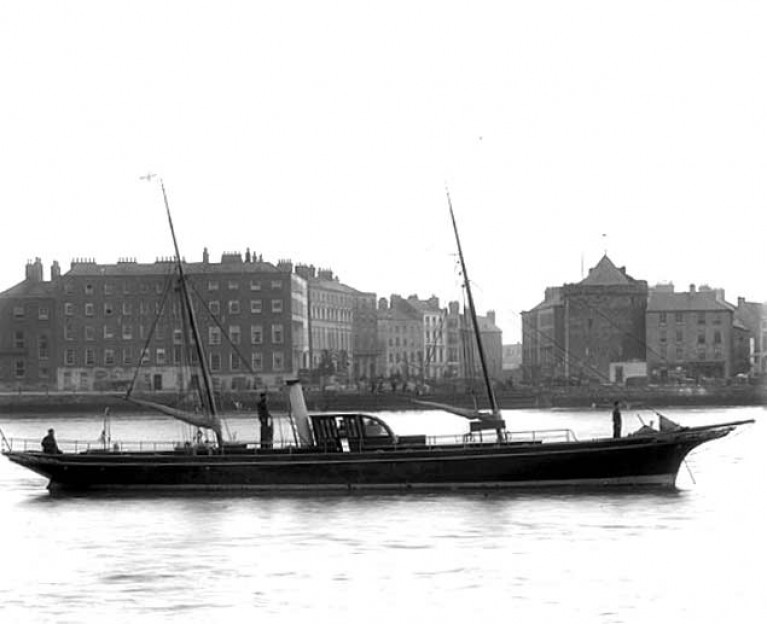Displaying items by tag: steamship
When we think of timelessly beautiful yachts, we’ll naturally think of sailing vessels, where beauty is created by a sweet harmony of the hull lines with an elegantly restrained sheer, combined with a rig which is all of a piece both with itself, and with the hull it drives through the water with as little fuss and effort as possible.
Over the years, over the centuries indeed, a small but significant number of such beauties have been built in Ireland to a design standard which matches the international benchmark. That benchmark was set in times past by the designs of Wanhill of Poole and Richardson of Liverpool, of G L Watson, William Fife and Alfred Mylne of Scotland, and Charles E Nicholson of England, together with Nat Herreshoff and John Alden of America.
More recently the baton was taken up by England’s Robert Clark and Arthur Robb and several Scandinavian designers, while in America Phil Rhodes, Olin Stephens, Jim McCurdy and German Frers of Argentina were recognized as the masters.
These are designers whose work still referenced the yacht most often though of as the most beautiful of all, the creation of 1893 which embodied what designer, critic and nautical writer Dixon Kemp described as the “Britannia Ideal” to which he expected all proper yachts to aspire.
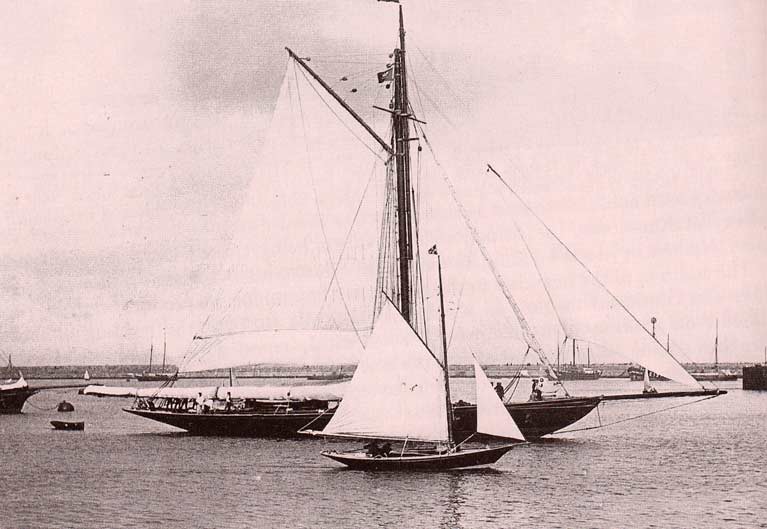 It’s May 1893, and Dublin yachtsmen get a first chance to see the new Britannia as she calls to Kingstown on Dublin Bay under a very shortened passage-making rig, with owner’s representative Willie Jameson on board during the maiden voyage in rugged weather from the builders in the Clyde to the Solent
It’s May 1893, and Dublin yachtsmen get a first chance to see the new Britannia as she calls to Kingstown on Dublin Bay under a very shortened passage-making rig, with owner’s representative Willie Jameson on board during the maiden voyage in rugged weather from the builders in the Clyde to the Solent
This was the Prince of Wales’ own 122ft cutter Britannia, designed by G L Watson and built on the Clyde by D & W Henderson, with top amateur sailing skipper Willie Jameson of Portmarnock in Dublin - a member of the noted Irish whiskey distilling family - acting as owner’s executive agent throughout the design, build and commissioning project, which was arguably the high point of the Golden Age of Scottish yacht building.
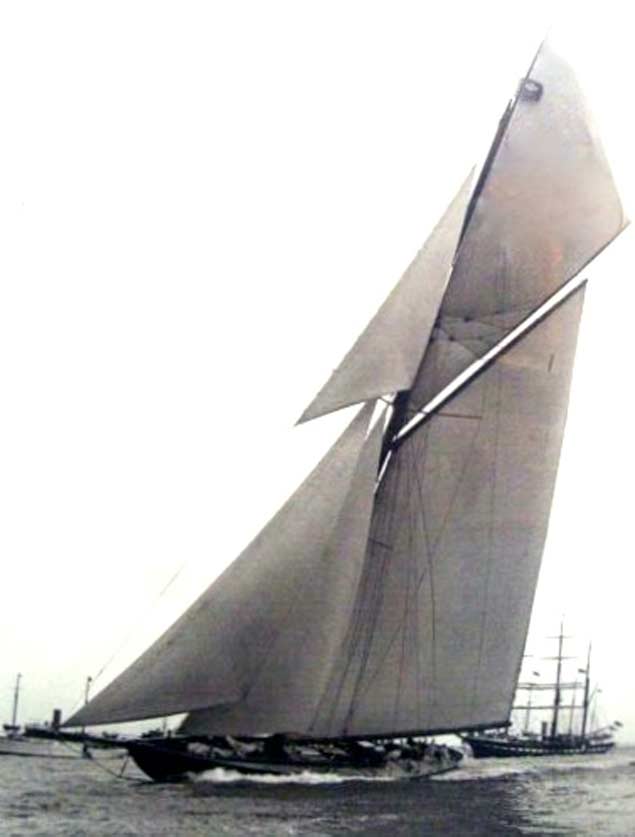 The “Britannia Ideal” as seen under full power while racing during Cowes Week
The “Britannia Ideal” as seen under full power while racing during Cowes Week
Britannia certainly set a high standard for what was thought of in 1893 as “the new look” for yachts, though for some her curved stem was just too much, and they stayed with more traditional clipper bows.
In Ireland from time to time creations of the highest standard appeared from local builders to the plans of international design talent, notable clipper-bowed examples still very healthily in existence being Hal Sisk’s superbly-restored G L Watson-designed 36ft cutter Peggy Bawn, built by Hilditch of Carrickfergus in 1894, and the 43ft Fife cutter Pen Duick, built to a William Fife design in Carrigaloe on Cork Harbour in 1898, and best-known for her long association with Eric Tabarly.
 Hal Sisk’s Peggy Bawn - designed G L Watson, built Hilditch of Carrickfergus 1894 - setting a suit of virtually unused cotton sails. They were found among the store of equipment when he bought the classic cutter for a restoration which was completed in 2005. Photo: Afloat.ie/David O’Brien
Hal Sisk’s Peggy Bawn - designed G L Watson, built Hilditch of Carrickfergus 1894 - setting a suit of virtually unused cotton sails. They were found among the store of equipment when he bought the classic cutter for a restoration which was completed in 2005. Photo: Afloat.ie/David O’Brien
 The 43ft Pen Duick of Eric Tabarly fame is a William Fife design built at Carrigaloe on Cork Harbour in 1898
The 43ft Pen Duick of Eric Tabarly fame is a William Fife design built at Carrigaloe on Cork Harbour in 1898
At the same time “spoon-bowed” yachts to Fife’s designs were also appearing, with the Cork Harbour One Designs in 1895, and a series of Belfast Lough One designs from both Fife and Alfred Mylne from 1896 to 1910.
Alfred Mylne became the “go to” designer for good-looking Irish One Designs with the Belfast Lough Stars in 1900 and the Dublin Bay 21s in 1902, then came the 39ft Island Class cruiser-racer yawls in 1910, while in more modern times he was still on the pace with the introduction of Bermudan rig with the 28ft 6ins River Class – now all in Strangford Lough – in 1921, the Dublin Bay 24s in 1938, and the 25ft Glens in 1947.
These were One Design racers, but after World War II in 1945, Crosshaven Boatyard began to function in various forms with fast cruisers and offshore racers, and from it - under Denis Doyle’s stewardship - there emerged some notably handsome craft, particularly the “white Moonduster”, a Robert Clark 47-footer from 1965, the very elegant and successfully functional Gypsy Moth V (also from Robert Clark) for Francis Chichester in 1970, the ruggedly good-looking Sparkman & Stephens 49ft “Blue Moonduster” of 1973, and arguably the star of them all, the handsomely varnished Frers 51 Moonduster of 1981, a yacht with such presence that she seemed to glow.
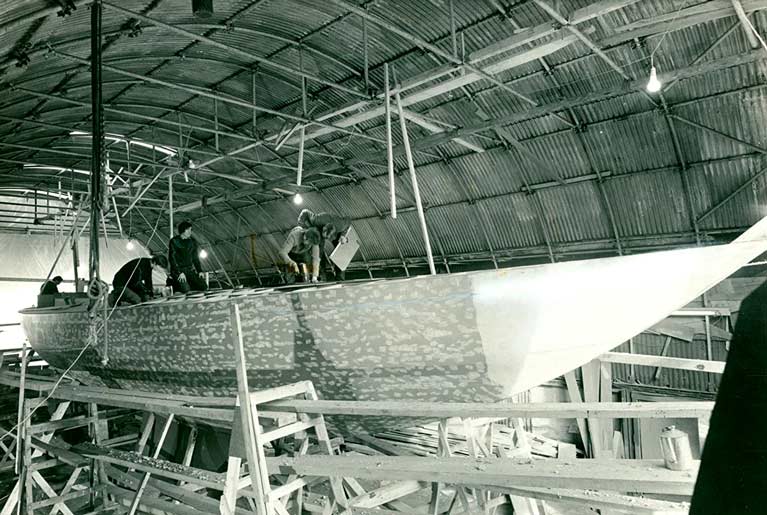 Francis Chichester’s Robert Clark-designed Gypsy Moth V building at Crosshaven Boatyard, January 1970.
Francis Chichester’s Robert Clark-designed Gypsy Moth V building at Crosshaven Boatyard, January 1970.
 Gypsy Moth V newly-launched at Crosshaven, July 1970. Photo: W M Nixon
Gypsy Moth V newly-launched at Crosshaven, July 1970. Photo: W M Nixon
The fastidious New Zealand-born designer Arthur Robb also had his adherents, with the elegant 37ft yawl Verve (now owned by the Comerford family of Dun Laoghaire) built for Paul Campbell by Jack Tyrrell of Arklow in 1964, while at the same time at Bangor Shipyard in the shores of Ballyholme Bay, the long task of building the 42ft Jaynor was under way for Ivan Selig of Belfast with Admiral's Cup prospects for 1965 in mind.
 The Arthur Robb-designed Jaynor, built at Bangor Shipyard on Ballyholme Bay in 1967, racing at the Glandore Classics under the ownership of the late Dickie Brown in 2003.
The Arthur Robb-designed Jaynor, built at Bangor Shipyard on Ballyholme Bay in 1967, racing at the Glandore Classics under the ownership of the late Dickie Brown in 2003.
In fact, Jaynor was built with such total attention to detail (the designer provided a total of 64 exquisitely-finished drawings) that she was barely ready for the 1967 Admiral’s Cup, but she is still very much in existence, a credit to the skills of the Bangor shipwrights, and a worthy addition to the list of beautiful world-standard sailing yachts built in Ireland.
Yet in looking for beautiful yachts with Irish links, should we restrict ourselves to sailing boats? In one of those burrowing searches which have played such a useful role in getting us through the Lockdown, we were looking for one particular black and white photo, and instead came across something else altogether.
 The 58ft Phoenix – built in Waterford of Lowmoor iron in 1872 - in fine “steaming” form on Lough Derg, September 1982. Photo: W M Nixon
The 58ft Phoenix – built in Waterford of Lowmoor iron in 1872 - in fine “steaming” form on Lough Derg, September 1982. Photo: W M Nixon
This image of John and Sandra Lefroy’s Killaloe-based 58ft 6in Phoenix steaming briskly at full chat across Lough Derg just for the hell of in the Autumn of 1982 brings back memories and then some. It was taken after Phoenix provided Committee Boat services at the Helmsman’s Championship at Dromineer in Shannon One Designs, with Dave Cummins of Howth – crewed by Gordon Maguire and Mossy Shanahan - successfully defending the title he’d won in Squibs at Howth in 1981.
“Steaming” isn’t quite the word, as Phoenix is diesel-powered and at season’s end her injectors needed a little attention. But as she happened to have been built way back in 1872, this impression of a steam-ship at speed was just what was needed, and in a flash of brief Autumn sunshine we also got a colour version of this photo which graced the cover of Motorboat & Yachting, where the plume of funnel smoke was just the job to emphasise that Phoenix was already 110 years old, and now she is within two years of her 150th anniversary.
 Golden Oldies Triumphant…..The 1872-vintage Phoenix on Committee Boat duty at a Classics Regatta at Dromineer on Lough Derg with the 1898-built Howth 17 Aura in the foreground, and the lake filled with boats of the Water Wag class (1887 & 1900) and the Shannon One Designs (1922). The combined age of the boats in this photo exceeds 2,000 years. Photo: Gerardine Wisdom
Golden Oldies Triumphant…..The 1872-vintage Phoenix on Committee Boat duty at a Classics Regatta at Dromineer on Lough Derg with the 1898-built Howth 17 Aura in the foreground, and the lake filled with boats of the Water Wag class (1887 & 1900) and the Shannon One Designs (1922). The combined age of the boats in this photo exceeds 2,000 years. Photo: Gerardine Wisdom
Although in the brisk breeze there was quite a lively Lough Derg chop running, with her beam of only 10ft, heavy displacement and hollowish waterlines forward, the Phoenix is steady as a rock nd slicing through it with ease, with her bow-wave well aft from the sharp straight stem, for this is one classy yacht. And just seeing her again was a reminder that while G L Watson made his name in superb sailing yachts, the bread-and-butter income from his design practice came from creating large, luxurious and extremely elegant steam yachts for the ludicrously wealthy industrialists and railroad barons to be found on both sides of the Atlantic in the final decades of the 1900s.
In doing this, Watson was emulating the path set by an almost-forgotten Irish yacht designer, St Clare John Byrne (1831-1915), the son of a ship owner from Ireland who had settled in Birkenhead across from Liverpool with his Scottish wife, where the son soon became a rising star in the design offices of the busy shipyards. He proved to have an exceptional talent for creating large (some of them extremely large) steam yachts, but he was also the designer of the steam-and-sail 152ft barquentine Sunbeam of 1874, which the global railway engineer Thomas Brassey cruised round the world with his family.
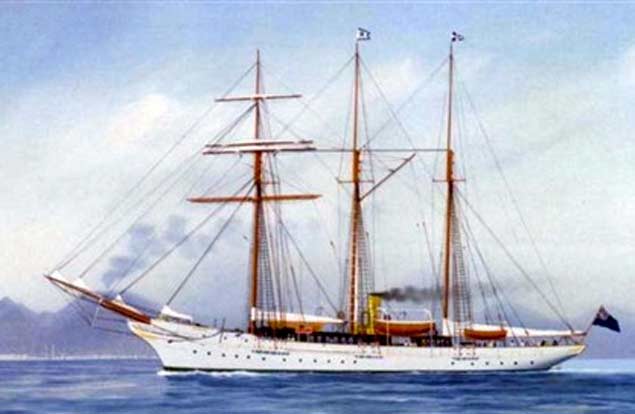 Thomas Brassey’s world-girdling 152ft auxiliary barquentine Sunbeam of 1874 was St Clare Byrne’s most famous design
Thomas Brassey’s world-girdling 152ft auxiliary barquentine Sunbeam of 1874 was St Clare Byrne’s most famous design
Like Watson a decade or so later, Byrne could create steam yachts which combined classic beauty with on-board comfort and sea-going power, works of art which could match any sailing yacht for beauty, and this was something which came very much to mind in delving back into the origins of Phoenix. She was designed and built in the Waterford region, using quarter inch Lowmoor iron, by the Neptune Shipyard to the designs of Andrew Horn, yet according to some records she was built by the Malcolmson Brothers of Portlaw.
“Waterford region” is used advisedly, for we’re into complex territory here. Portlaw is that extraordinary 19th Century “model village” 19 km upstream of Waterford city on the River Suir, built up as a planned industrial unit from 1825 onwards by the Malcolmson family to such a state of prosperity that, by its peak, it was employing 1800 people – with housing provided – at a time when much of rural Ireland was in grinding poverty.
It seemed the Malcolmson brothers could turn their hand to anything, and their development of steamships in tandem with the growth of their conglomerate meant that at one stage, they actually owned more steamships in vessel numbers than any other single company in the world.
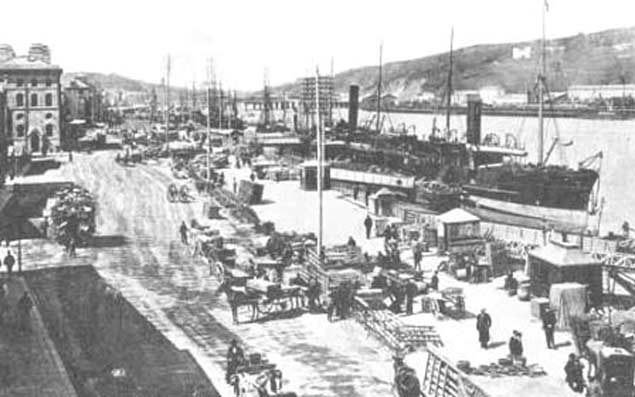 The busy quays in Waterford around 1900. The Malcolmsons had been so successful in pioneering steamship building and development in the middle decades of the 19th Century that at one stage they had the numerically-largest fleet of steam-driven vessels in the world
The busy quays in Waterford around 1900. The Malcolmsons had been so successful in pioneering steamship building and development in the middle decades of the 19th Century that at one stage they had the numerically-largest fleet of steam-driven vessels in the world
But what goes up eventually comes down, and by the 1870s cracks were beginning to appear, so although the Phoenix may have been built in Portlaw, as the industrial edifice created there began to crumble, the ship-building seems to have been hived off to this Neptune Shipbuilding company more directly linked to Waterford city, although the Neptune Ironworks had been associated with Portlaw since 1840.
Whatever the story – and it’s surely worthy of a TV drama series, for there were all sorts of family tensions involved – Andrew Horn, the in-house yacht designer who drew the plans for Phoenix, has emerged in the 1880s as the designer to the Neptune Shipbuilding Company in Waterford, and in 1882 with some input from St Clare Byrne, he designed and oversaw the building in iron of the 77ft steam yacht Maritana, all of 30 tons in deadweight and 56 tons TM, but skinny like a greyhound in the Phoenix style.
Maritana was built for Thomas St Leger Atkins of Waterford, and the photo of her in her first year afloat says everything, elegantly posed as she is at anchor in the river off Reginald’s Tower as a proud statement of Waterford’s achievement. In design terms, Andrew Horn has moved on from Phoenix’s straight stem and has given Maritana a clipper-bowed look which to my mind, when combined with a sheerline of saintly restraint and the neatly-tucked counter stern, makes her the best-looking yacht – sail or power - to have ever come out of Ireland, and the fact that she was both Irish-designed and built is a bonus.
Waterford’s high opinion of her was shared in Cowes, where she was awarded the Concours d’Elegance at the regatta in 1884. But it couldn’t be an Irish story without the inevitable serving of sadness to round it out. Maritana was the last vessel created by the Neptune Shipbuilding Company. It followed the Malcolmson conglomerate into oblivion soon after her completion.
As for what happened subsequently to the exquisite Maritana, according to the ever-helpful USB of all Lloyd’s Registers (assembled from its foundation in 1878 to the final edition in 1980 by the Association of Yachting Historians), after some years in Waterford, she was sold to Milford Haven in Wales, and by the turn of the century she was in Belfast Lough ownership before returning to southwest Wales, but with an owner based in Sunderland. Eventually, she disappears from the records. Some well-resourced research department may wish to follow the trail. But for the rest of us, that captured moment of the most beautiful Irish yacht of all, anchored off Waterford in 1882, is enough to be going on with.



























